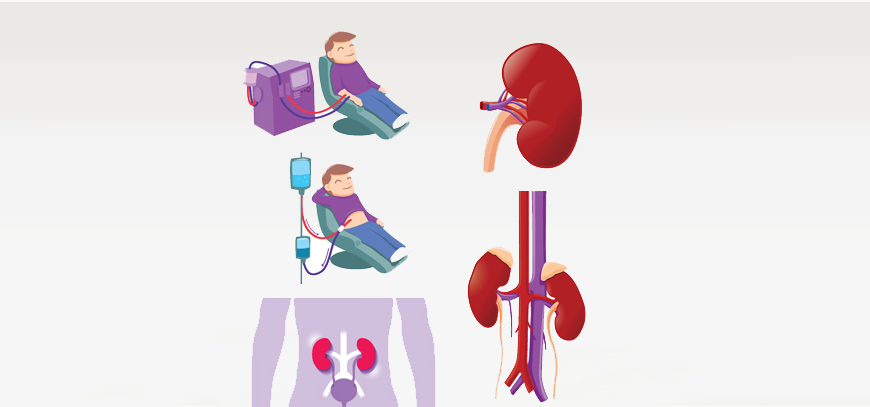Working Time
- Mon-Thu 08:00 – 20:00
Friday 07:00 – 22:00
Saturday 08:00 – 18:00
Contact Info
-
Phone: 92-3324520052
92-3310232883
Ask the Experts
Dialysis Access Care and Management

What is Dialysis?
Dialysis allows people with kidney failure (renal failure) a chance to live productive lives. When kidney function decreases to a critical level or complications arise, a person may need to start dialysis. There are two main types of dialysis, hemodialysis and peritoneal dialysis.
IRCC Pakistan Dialysis Access Care Management
We offer the following ways to establish and maintain your dialysis access
Permacath
What is permacath?
A permacath is a piece of plastic tubing that is similar to a jugular catheter. It is used for hemodialysis in the exact same way that a jugular catheter is used. The advantage of the permacath is that it can provide access to the vascular system for up to one year. This is important for dialysis patients because they will avoid multiple catheter insertions, which could eventually lead to vein damage.
How does the procedure work?
Using a fluoroscopy machine and small tools, the interventional radiologist places the permacath in the jugular vein. The permacath is moved under the skin throughout the upper chest, under the collarbone, and the end of the catheter comes out on the chest wall. The fluoroscopy is used in order for the IR to follow the path of the catheter throughout the procedure and make sure it is placed correctly.
Peritoneal Dialysis
What is peritoneal dialysis and how does it work?
Peritoneal dialysis is a treatment for kidney failure that uses the lining of your abdomen, or belly, to filter your blood inside your body. Doctors call this lining the peritoneum. An interventional radiologist will place a soft tube, called a catheter, in your belly a few weeks before you start treatment.
When a dialysis technician chooses to do peritoneal dialysis at home or dialysis center, they will consult with their doctor about which type of PD they will perform: Continuous ambulatory peritoneal dialysis (CAPD), which is done manually without a machine. Automated peritoneal dialysis (APD), which is done with a machine called a cycler.
AV Fistula Angioplasty and Stenting
Dialysis fistula/graft declotting interventions improve blood flow in fistula and grafts – artificial blood vessel connections used to facilitate kidney dialysis, a treatment that uses a special machine to remove waste materials from the body. These connections can clog or narrow and require angioplasty and vascular stenting or catheter-directed thrombolysis.
What are Dialysis and Fistula/Graft Declotting and Interventions?
Dialysis fistula/graft declotting and interventions are minimally invasive procedures performed to improve or restore blood flow in the fistula and graft placed in the blood vessels of dialysis patients.
-
a fistula, which is made by joining together an artery and vein to make a bigger high-flow blood vessel.
-
a graft, in which a soft plastic tube is placed between an artery and a vein, creating an artificial high-flow blood vessel.
What are some common uses of the procedure?
These procedures are used to treat:
-
Dilating the narrowed vessels of dialysis fistula and grafts.
-
Removing the thrombosed blood clot from fistula and graft.
Angioplasty and Vascular Stenting
Using imaging guidance, an inflatable balloon mounted at the tip of a catheter is inserted through the skin into the fistula or graft and advanced to the blockage. There, the balloon is inflated and deflated. In this process, the balloon expands the vein or artery wall, increasing blood flow through the fistula or graft. A stent may be placed to hold the vessel open.
Catheter-directed thrombectomy or thrombolysis: Using image guidance and a contrast material that helps show the blood vessel, your interventional radiologist will insert a catheter through the skin into a vessel (artery or vein) and direct it to the thrombosis, or blockage. The blood clot will then be dissolved in one of two ways:
-
by delivering medication directly to the blood clot (thrombolysis).
-
by positioning a mechanical device at the site to break up the clot (thrombectomy).
Benefits of Angioplasty/Declotting
Treating your dysfunctional access with angioplasty and thrombectomy has many benefits:
-
Blood flow to your AV fistula or graft is restored
-
Minimal or no disruption in your normal dialysis schedule
-
No surgery is required – a small skin puncture is made which will not require stitches
-
General anesthesia is not required
-
No hospital stay is involved
-
Return to daily activities shortly after your procedure
Catheter-directed Thrombolysis
-
Catheter-directed thrombolysis can greatly improve blood flow and reduce or eliminate the related symptoms and effects without the need for more invasive surgery.
-
Thrombolysis is a safe, highly effective way of re-establishing circulation blocked by a clot.
-
Thrombolysis is less invasive than conventional open surgery to remove clots and the hospital stay is relatively brief. Blood loss is less than with traditional surgical treatment and there is no obvious surgical incision.
Recanalization of Central Venous occlusions
Central vein occlusion (CVO) is a common complication in chronic hemodialysis patients due to mechanical damage to the vessel walls from prior catheterization, as well as high flow rate of a functioning arteriovenous fistula (AVF). CVO could result in ipsilateral limb swelling and altered vascular access function, leading to suboptimal hemodialysis sometimes with superior vena caval syndrome resulting in facial swelling, puffiness, headache and tinnitus.
Central venous recanalization are practical strategies in treating long-segment CVO in hemodialysis patients crossing with standard wires, sharp needles and sometimes with central venous occlusion reentry devices in establishing and restoring flow through the central venous system resulting in clinical improvements.
Our management is committed to providing you with the latest in state of the art imaging, diagnostic and interventional services, and education to meet your dialysis access needs.
We established a Dialysis Access Center to provide prompt, state-of-the-art care to patients who need to have a dialysis access created or repaired before undergoing or continuing hemodialysis or peritoneal dialysis.

